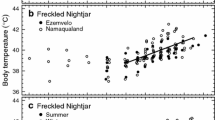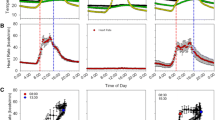Summary
-
1.
The dynamics of temperature regulation on a diurnal and annual basis were studied in seasonally acclimatized Willow Tits. The diurnal thermoregulation pattern of the tits was the same at all seasons of the year, i.e. at roosting time the body temperature gradually fell until it levelled off at some time between 2100 and 2200h. Then the body temperature remained more or less constant until two to three hours before sunrise, when it gradually rose to the normal daytime level by the start of the daytime activity period (Fig. 1 and 3 A-B).
-
2.
Body temperature and O2-consumption rates were recorded on winter acclimatized Willow Tits, exposed to a series of different but constant ambient temperatures during night. The values at which the body temperature levelled off at night was significantly correlated with that of the ambient temperature (Fig. 2). Energy expenditure on an overnight basis was lowered considerably when the tits entered nocturnal hypothermia (Fig. 5).
-
3.
The Willow Tits showed a marked seasonal variation with regard to the depth of hypothermia achieved when they were exposed to different ambient temperatures. The maximum response was observed in mid-winter acclimatized birds, whereas mid-summer acclimatized birds showed almost no response. Between these two extremes, a steady gradient was found (Fig. 4).
-
4.
The observed nocturnal hypothermia was a controlled physiological response to low ambient temperature and long winter nights. All the birds in the experiment arose to the normal diurnal body temperature in the morning.
Similar content being viewed by others
References
Aschoff J (1970) Circadian rhythm of activity of and of body temperature. In: Hardy JD, Gagge AP, Storwijk JAJ (eds) Physiological and behavioral temperature regulation. Thomas, Springfield, Illinois
Aschoff J, Biebach H, Heise A, Schmidt T (1974) Day-night variation in heat balance. In: Monteith JL, Mount LE (eds) Heat loss from animals and man; assessment and control. Proc 20th Easter School in Agricultural Science, University of Nottingham, 1973. Butterworths, London
Biebach H (1977) Reduktion des Energiestoffwechsels und der Körpertemperatur hungernder Amseln (Turdus merula). J Ornithol 118:294–300
Budd SM (1973) Thermoregulation, bioenergetics, and endocrinology of cold acclimatization of black-capped chickadees, (Parus atricapillus). Doctoral thesis, Cornell University, Ithaca, New York
Chaplin SB (1974) Daily energetics of the black-capped chickadee,Parus atricapillus, in winter. J Comp Physiol 89:321–330
Chaplin SB (1976) The physiology of hypothermia in the black-capped chickadee,Parus atricapillus. J Comp Physiol 112B:335–344
Cheke RA (1971) Temperature rhythms in African montane sunbirds. Ibis 113:500–506
Dawson WR, Hudson JW (1970) Birds. In: Whittow GC (ed) Invertebrates and nonmammalian vertebrates: (Comparative physiology of thermoregulation, vol 1. Academic Press, New York London, pp 223–310
Decopas F, Hart JS (1957) Use of the Pauling oxygen analyzer for measurement of oxygen consumption of animals in open circuit systems and in a short-lag, closed-circuit apparatus. J Appl Physiol 10:388–392
Grossman AF, West GC (1977) Metabolic rate and temperature regulation of winter acclimatized black-capped chickadeesParus atricapillus in interior Alaska. Ornis Scand 8:127–138
Haftorn S (1972) Hypothermia in Tits in the arctic winter. Ornis Scand 3:153–166
Haftorn S (1982) Variation in body measurements of the Willow TitParus montanus, together with a method for sexing live birds and data on the degree of shrinkage in size after skinning. Fauna Norv [C] 5:16–26
Haftorn S, Reinertsen RE (1982) Regulation of body temperature and heat transfer to eggs during incubation. Ornis Scand 13:1–10
Heller HC, Crawshaw LJ, Hammel HT (1978) The thermostat of vertebrate animals. Sci Am 239:88–96
Hill RH, Beaver DL, Veghte JH (1980) Body surface temperatures and thermoregulation in the Black-capped Chickadee (Parus atricapillus). Physiol Zool 53:305–321
Jaeger EC (1948) Does the Poor-will ‘hibernate’? Condor 50:45
Jaeger EC (1949) Further observations on the hibernation of the Poor-will. Condor 51:105–109
Kleiber M (1961) The fire of life. Wiley, New York
Prinzinger R, Göppel R, Lorenz A, Kulzer E (1981) Body temperature and metabolism in the red-backed mousebild (Colius castanotus) during fasting and torpor. Comp Biochem Physiol [A] 69:689–692
Reinertsen RE (1980) A telemetry study on deep body temperature of the Willow Tit (Parus montanus). Acta Physiol Scand 108:32A
Reinertsen RE (1982) Radio telemetry measurements of deep body temperature of small birds. Ornis Scand 13:11–16
Rising JD, Hudson JW (1974) Seasonal variation in the metabolism and thyroid activity of the black-capped chickadee (Parus atricapillus). Condor 76:198–203
Steen JB (1958) Climatic adaptation in some small northern birds. Ecology 39:625–629
Veghte JH (1964) Thermal and metabolic responses of the gray jay to cold stress. Physiol Zool 37:316–328
Wolf LL, Hainsworth FR (1972) Environmental influence on regulated body temperature in torpid humming-birds. Comp Biochem Physiol 41:167–173
Author information
Authors and Affiliations
Rights and permissions
About this article
Cite this article
Reinertsen, R.E., Haftorn, S. Nocturnal hypothermia and metabolism in the Willow TitParus montanus at 63° N. J Comp Physiol B 151, 109–118 (1983). https://doi.org/10.1007/BF00689908
Accepted:
Issue Date:
DOI: https://doi.org/10.1007/BF00689908




